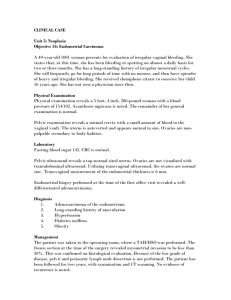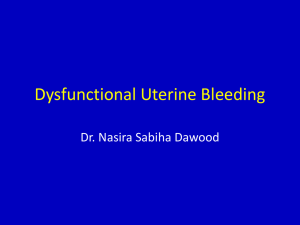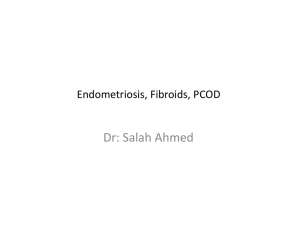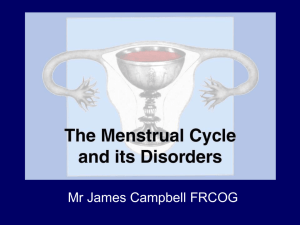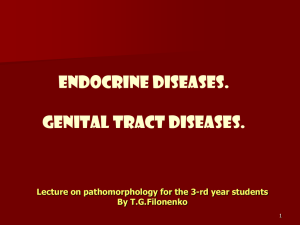UTERINE CORPUS
advertisement
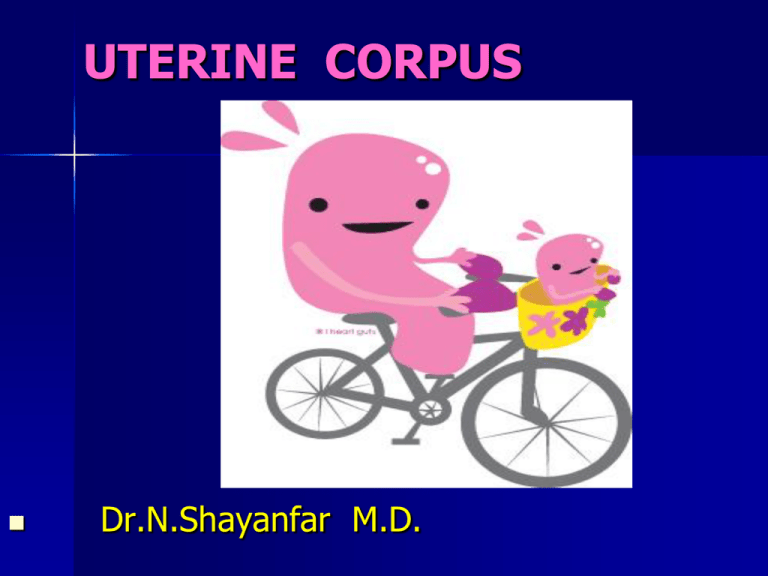
UTERINE CORPUS Dr.N.Shayanfar M.D. Endometrium Myometrium UTERINE WALL HISTOLOGY OF THE MENSTRUAL CYCLE Proliferative phase(first 2 weeks) Secretory phase(last 2 weeks) PROLIFERATIVE PHASE Growth of both glands and stroma Glands:straight,tubular Lining:pseudostratified columnar cells Mitotic figures:numerous Stroma:compact spindle cells with scant cytoplasm & numerous mitotic activity EARLY POST MENSTRUAL ENDOMETRIUM PROLIFERATIVE PHASE PROLIFERATIVE PHASE SECRETORY PHASE Glands: basal secretory vacuoles secretion tortusity of glands(serrated or saw-toothed appearance) Stroma: Spiral arterioles Days 21-22 Stromal edema Predecidual change Days 23-24 Leukocytic infiltration Days 27-28 EARLY SECRETORY PHASE SECRETOPRY PHASE SECRETORY PHASE DATING OF ENDOMETRIUM Assess hormonal status Causes of AUB Causes of infertility PATHOLOGY Functional endometrial disorders Inflammations Endometriosis Adenomyosis Endometrial polyps Endometrial hyperplasia Malignant neoplasms ABNORMAL UTERINE BLEEDING(AUB) Common Menorrhagia: profuse or prolonged bleeding at the time of period Metrorrhagia: irregular bleeding between the periods Postmenopausal bleeding Common causes: Polyps, leiomyomas, hyperplasias, carcinomas, endometritis ABNORMAL UTERINE BLEEDING(AUB) Dysfunctional uterine bleeding Organic lesions Depends on the age of the patient Age group Causes Prepuberty Precocious puberty Adolescence Anovulatory cycle Reproductive age Complications of pregnancy Organic lesions Anovulatory cycles Ovulatory dysfunctional bleeding Perimenopausal Anovulatory cycle Irregular shedding Organic lesions Post menopausal Organic lesions Endometrial atrophy DYSFUNCTIONAL UTERINE BLEEDING Failure of ovulation(anovulatory cycle) Inadequate luteal phase Contraceptive induced bleeding DEFINITION Abnormal bleeding in the absence of a welldefined organic lesion in the uterus ANOVULATORY CYCLES Are very common at both ends of reproductive life An endocrine disorder(thyroid,adrenal, hypothalamic-pituatory axis) A primary lesion of the ovary(PCO,tumors) Generalized metabolic disturbance(obesity,malnutrition,chronic systemic disease) Severe physical or emotional stress Subtle hormonal imbalance AN EXESS OF ESTROGEN RELATIVE TO PROGESTRONE The endometrium goes through a proliferative phase, not followed by the normal secretory phase Mild cystic changes or disorderly appearance of endometrial glands The endometrial stroma may be scarce Prone to breakdown and abnormal bleeding INADEQUATE LUTEAL PHASE Inadequate corpus luteum function (fail to mature, regress prematurely) Low progestrone output Biopsy: Estimated secretory change lags with respect to the expected date Contaceptive-induced bleeding Older OCPs Lush decidua like stroma & inactive nonsecretory glands INFLAMMATIONS(ENDOM ETRITIS) Acute endometritis(after delivery or miscarriage) Chronic endometritis: -chronic PID -postpartal or postabortal -IUDs -tuberculosis -in 15% no primary cause Plasma cells.macrophages.lymphocytes & irregular proliferation of endometrial glands Clinically:AUB,pain,discharge,infertility Adenomyosis Growth of the basal layer of the endometrium down into the myometrium Induces reactive hypertrophy of the myometrium Enlarged globular uterus Do not undergo cyclic bleeding Menorrhagia, dysmenorrhea & pelvic pain ENDOMETRIOSIS Presence of endometrial glands or stroma in a locations outside the uterus (endomyometrium) In 10% of women in their reproductive years, in nearly half of women with infertility, 3rd & 4th decades Frequently multifocal, often involves pelvic structures Locations: ovaries, pouch of Douglas, uterine ligaments, rectovaginal septum, tubes, pelvic peritoneum, laparotomy scars, rarely umiblicus, vagina vulva or appendix Less frequently: LN, lungs, heart, SM, bone Origin: Regurgitation theory, Metaplastic theory, vascular or lymphatic dissemination theory Recent studies: Endometriotic tissue is not just misplaced but is also abnormal Increased level of inflammatory mediators (PGE2), increased estrogen production (aromatase activity) COX-2 inhibitors & Aromatase inhibitors Ovarian Endometriosis (Chocolate cyst) Clinical Manifestations Depends on distribution of lesions Extensive scarring of oviducts and ovaries: Discomfort in lower abdominal quadrants, Sterility Rectal wall involvement: painful defication Involvement of uterine or bladder serosa: dyspareunia & dysuria Dysmenorrhea, pelvic pain (intrapelvic bleeding & periuterine adhesions) PROLIFERATIVE LESIONS OF THE ENDOMETRIUM & MYOMETRIUM ENDOMETRIAL POLYP Sessile, hemispheric 0.5-3 cm Endometrium resembling the basalis Small muscular arteries Stomal cells are monoclonal (6p21) Most commonly: around the time of menopause AUB, rare risk of cancer ENDOMETRIAL POLYP ENDOMETRIAL HYPERPLASIA(EIN) An important precursor endometrial carcinoma Prolonged or marked excess of estrogen relative to progestin Exaggerated endometrial proliferation (Hyperplasia) Predisposing conditions: Failure of ovulation, PCO, Functioning GCT of ovary, prolonged adminstration of estrogenic substances, obesity Severity: Level & duration of estrogen excess Simple, complex, atypical Risk of developing carcinoma: Presence of cellular atypia 5% vs 2050% Inactivating mutations of PTEN tumor suppressor gene (del,inact) The endometrial cavity is opened to reveal lush fronds of hyperplastic endometrium. Endometrial hyperplasia usually results with conditions of prolonged estrogen excess and can lead to metrorrhagia (uterine bleeding at irregular intervals), menorrhagia (excessive bleeding with menstrual periods), or menometrorrhagia. Simple nonatypical hyperplasia Complex atypical hyperplasia(EIN) Loss of PTEN gene ENDOMETRIAL CARCINOMA Adenocarcinoma The most frequent invasive cancer of the female genital tract Molecular Pathogenesis Type I Type II Characteristics Type I Type II Age 55-65 yr 65-75 yr Clinical setting Unopposed estrogen Breast cancer Atrophy Thin physique Obesity Hypertension Diabetes Infertility Morphology Endometrioid Serous carcinoma 80% 15% Precursor Hyperplasia Endometrial intraepithelial carcinoma Molecular genetics PTEN,mismatch repair genes, p53 (uncommon) P53, Behavior Indolent Aggressive Spreads via lymphatics Intraperitoneal and lymphatic spread Type I Carcinomas The most common type (> 80% of all cases) Majority are well differentiated (Endometrioid carcinoma) Estrogen-secreting ovarian tumors Associated with:1) obesity, 2) diabetes , 3) hypertension, 4) infertility , 5) unopposed estrogen stimulation Morphology Gross morphology: * A localized polypoid tumor * A diffuse (infiltrative) tumor Myometrial invasion, Dissemination to the regional lymph nodes , metastasize to the lungs, liver, bones, and other organs Microscopy Endometrioid adenocarcinomas characterized by gland patterns resembling normal endometrial epithelium A range of histologic types: Mucinous, tubal (ciliated), & squamous differentiation A three-step grading system is applied to endometrioid tumors (I-III) This adenocarcinoma of the endometrium is more obvious. Irregular masses of white tumor are seen over the surface of this uterus that has been opened anteriorly. The cervix is at the bottom of the picture. This enlarged uterus was no doubt palpable on physical examination. Such a neoplasm often present with abnormal bleeding. ENDOMETRIAL ADENOCARCINOMA This is endometrial adenocarcinoma which can be seen invading into the smooth muscle bundles of the myometrial wall of the uterus. This neoplasm has a higher stage than a neoplasm that is just confined to the endometrium or is superficially invasive. MYOMETRIAL INVASION Type II Carcinomas A decade later than type I carcinoma Usually arise in the setting of endometrial atrophy Are by definition poorly differentiated (grade 3) tumors Approximately 15% of cases of endometrial carcinoma The most common subtype is serous carcinoma Morphology Large bulky tumors or deeply invasive into the myometrium All of the non-endometrioid carcinomas are classified as grade 3 (high grade) irrespective of histologic pattern Form small tufts & papillae, much greater cytologic atypia High levels of p53 on IHC Papillary serous carcinoma Clinical Course Irregular or postmenopausal vaginal bleeding with excessive leukorrhea Fixation to surrounding structures Slow to metastasize The prognosis depends heavily on the clinical stage of the disease, its histologic grade and type Serous tumors: stage, cytology of peritoneal washings Staging I confined to the corpus II Corpus & cervix III extends outside the uterus but not true pelvis IV extends outside the true pelvis or involving bladder or rectum TUMORS OF THE MYOMETRIUM Benign:Leiomyomas(fibroids) Malignant:Leiomyosarcoma LEIOMYOMA The most common benign tumors in females 30-50% of women of reproductive age Monoclonal Rearrangement of chromosome 6 & 12 Estrogen & OCP: stimulate the growth Shrink postmenopausally MORPHOLOGY Sharply circumscribed Firm gray masses Whorled cut surface More often multiple tumors, intramural,submucosal, subserosal, parasitic Histology Foci of calcification fibrosis, degeneration LEIOMYOMA LEIOMYOMATA LEIOMYOMA Here is a very large leiomyoma of the uterus that has undergone degenerative change and is red (so-called "red degeneration"). Such an appearance might make you think that it could be malignant. Remember that malignant tumors do not generally arise from benign tumors, which is a good thing, because leiomyomas are so common (20% of women will have at least one). Postmenopausally, leiomyomas tend to regress in size and become fibrotic. Clinical Manifestations Often are asymptomatic (incidental) Menorrhagia (most frequent) Palpable mass, or dragging sensation Almost never transform into sarcoma LEIOMYOSARCOMA Arise de novo from the mesenchymal cells of the myometrium Almost always are solitary Postmenopausal women (most often) Soft, hemorrhagic necrotic mass STUMP Tumor necrosis, cytologic atypia & mitotic activity Recurrence, metastasis (lungs) LEIOMYOSARCOMA LEIOMYOSARCOMA LEIOMYOSARCOMA FALLOPIAN TUBES HISTOLOGY FALLOPIAN TUBE HISTOLOGY FALLOPIAN TUBES Inflammations(most common) Ectopic pregnancy Endometriosis Tumors(uncommon) and cysts INFLAMMATIONS Almost always microbial in origin Gonorrhea, nongonococcal (chlamydia, mycoplasma hominis), coliforms, streptococci, staphylococci Suppurative salpingitis (gonococcus, chlamydiae) Nongonococcal: blood-borne Tuberculous salpingitis (important cause of infertility) PID Lower abdominal or pelvic pain, fever, pelvic mass, vaginal discharge Complications: Tubo-ovarian abscess, Peritonitis, intestinal obstruction, tubal ectopic pregnancy, infertility A remnant of tubal epithelium is seen here surrounded and infiltrated by numerous neutrophils. This is acute salpingitis. Neisseria gonorrheae was cultured. TUBO-OVARIAN ABSCESS TUBO-OVARIAN ABSCESS Salpingitis Tumors and cysts Paratubal cyst(hydatid of morgani) Adenomatoid tumor(mesothelioma) Adenocarcinoma(rare) Adenocarcinoma Serous or endometrioid types Serous types are increased in women with BRCA mutations Prophylactic oophorectomies: 10% occult foci of malignancy, usually in the fimbria Frequently involve the omentum and peritoneal cavity at presentation
